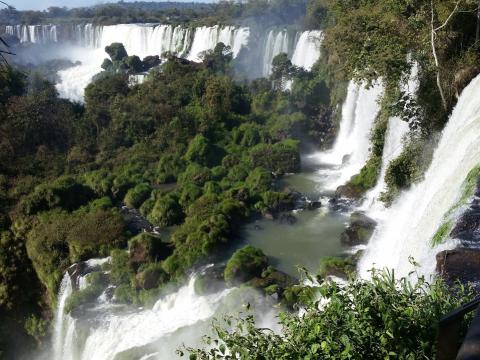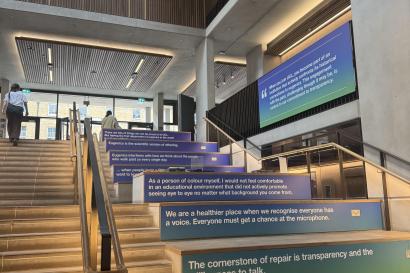
After living in Buenos Aires for only three weeks, we felt enough like porteños that we were ready to explore more of our new country. With our first long weekend to take advantage of in mid-August, our interest turned to Iguazu Falls, a famous range of waterfalls in northeastern Argentina that form the border between Argentina and Brazil.
With a subtropical climate, abundant wildlife, and a triple-digit amount of waterfalls, Iguazu is one of the seven natural wonders of the world and Niagara’s bigger, more beautiful sister. With countless pictures, videos, and even a few movie cameos throughout the years showing its natural beauty, we were all excited to see if Iguazu Falls lived up to the hype.
After an eighteen hour overnight bus trip from Retiro to Iguazu (advice: spring for the nicest seats on the bus—with meals, drinks, movies, and a reclining seat more comfortable than my freshman year twin bed, our VIP Suite seats were like upgrading to first class for only an extra $20 US) we arrived at Puerto Iguazu, the town closest to the falls, ready to begin exploring.
Puerto Iguazu is only a taxi ride away from each of the Iguazu national parks in Argentina and Brazil. To enter the Brazilian side, you usually need to get a Visa for the country, but we were lucky enough to visit during the Rio de Janeiro Olympics and took advantage of the waived entry fees during the time. Depending on your budget though, you can choose not to go to the Brazilian side of the park and still have an amazing experience exploring only the Argentine portion.

The Argentine side of the falls makes up almost eighty percent of Iguazu Falls, so there’s a lot to do and see at the park. The views were incredible—every few minutes we stopped for pictures at “the best” lookout point, only to be proved wrong when the view got even better a few meters later. The walking paths trailed around, next to, and even over different waterfalls so we got to see the waterfalls from all angles and had wonderful views of the line of waterfalls stretching hundreds of meters into the distance. Because we went to Iguazu during the off season, the walking trails were mostly empty except for Devil’s Throat, the most popular lookout where you can see a group of waterfalls converge into a glorious, misty basin.

Completely awed by the Argentine side of Iguazu, I was a bit nervous on Sunday that the Brazilian side wouldn’t be as impressive. While the Brazilian side is undoubtedly smaller and more touristy than the Argentine national park, it was equally striking. The Brazilian park overlooks the Argentine waterfalls, making for beautiful, unparalleled pictures of them—almost every photo I took was worthy of an Instagram (and that’s coming from someone with a very curated feed). There was an amazing lookout point near the end of the trail that let us stand right in front of the biggest waterfall on the Brazilian side and that also had spectacular views overlooking the Devil’s Throat basin.

Both sides of Iguazu were incredible; inspiring, powerful. Even after visiting Niagara Falls, I was completely unprepared for the roar of the water; the rainbows that floated over the crashing streams; the sense of peace I felt watching the chaos. It was a completely amazing experience, in every sense of the word. I do have one warning for anyone planning a trip to Iguazu Falls though: after seeing the majesty that is Las Cataratas de Iguazu, be prepared to never be impressed by another waterfall ever again.

Maria Oldenburg
<p>I am Maria Oldenburg, and I'm a sophomore Economics and International Studies double major at Case Western Reserve University in Cleveland, Ohio. On campus, you can find me pretending to be a professional photographer, exploring the local coffee scene, or hopelessly planning my dream backpacking trip across Southeast Asia. Originally from Pittsburgh, Pennsylvania, I can't wait to eat my weight in empanadas, learn quality puns in Spanish, and tango with the best of them during my semester in Buenos Aires!</p>





